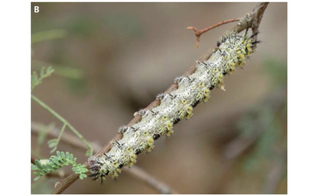Skin-Crawling Experience: Caterpillar Gives Woman Hives

Caterpillars' cute and fuzzy looks may make them seem harmless, and they usually are. But that wasn't the case for one woman in Arizona: Her left shoulder quickly erupted in an itchy, red rash after a brush with one of these critters.
The 42-year-old woman was in her backyard under a mesquite tree in October 2014, when a caterpillar landed on her back, just beneath her left shoulder, where her skin was exposed because she was wearing a tank top. She felt a stinging sensation and numbness, and within minutes, her skin in this area broke out in hives.
The woman went inside her house and took a picture of the skin reaction, which, by that point, had blossomed into good-size welts. She then returned to her yard to snap an image of the possible culprit. It was later identified as a tricolor buckmoth caterpillar (Hemileuca tricolor), according to a report of the woman's case, published online today (Oct. 28) in the New England Journal of Medicine.
Unsure about what to do, and wondering whether the caterpillar responsible for her rash was a poisonous species, the woman called the Arizona Poison and Drug Information Center for advice, and also sent her photographs.
Dr. Daniel Brillhart, an emergency medicine physician, was on duty when the woman called the poison center, and was a co-author of the case report. After looking at the photos and speaking with the woman, he determined that her skin rash was the result of an allergic reaction to the toxic substance that coats the hairs on the caterpillar's body, Brillhart said. [8 Strange Signs You're Having an Allergic Reaction]

When these toxin-coated hairs make contact with the skin, they trigger an immune-system reaction and can cause hives in most people, he said.
If a caterpillar falls onto a person's skin, it can cause more of a reaction than if it crawls onto the skin because fewer toxin-coated hairs are dislodged when a caterpillar crawls, Brillhart said. In addition, the woman in this case may have had a more severe reaction because the caterpillar fell onto her back, and the skin there is thinner than the skin on the hands or legs, he explained.
Sign up for the Live Science daily newsletter now
Get the world’s most fascinating discoveries delivered straight to your inbox.
Had the caterpillar hairs landed in her eyes, the woman could have developed conjunctivitis, a common eye infection also known as pink eye. And if the hairs had been released into the air and she breathed them into her lungs, it might have caused wheezing and difficulty breathing, said Brillhart, who is now a physician at Darnall Army Medical Center in Fort Hood, Texas.
Close encounter
Most caterpillars are harmless, Brillhart told Live Science. But the larger and fuzzier they appear, and the closer to the equator they are found, the more likely caterpillars are to cause allergic reactions, he said.
That's why, Brillhart said, he wouldn't advise children to play with caterpillars or for adults to pick them up with their hands. A stick or gardening gloves can be used to remove a caterpillar if it lands on a person's body or clothes.
Although they can cause allergic reactions, "caterpillars do not bite," Brillhart said. "Their mouths are not designed to pierce the skin," he said.
When Brillhart spoke with the Arizona woman on the phone, she told him that she had already washed her skin with soap and water, which helped to remove the caterpillar hairs. (Some poison control websites recommend gently applying and removing tape to strip away the hairs before washing the area.)
To calm her rash, which is also known as caterpillar dermatitis, he advised her to use cold compresses and apply an over-the-counter antihistamine cream. This treatment helped to clear up her irritated skin in a few days, according to the case report.
The woman recovered from her close encounter with a caterpillar with only telephone advice from the poison control center.
That is one of the advantages of U.S. poison control centers, Brillhart said. "They are designed to prevent doctor's visits for problems that can be managed at home," he noted.
However, if a person has difficulty breathing or weakness, or feels lightheaded after being exposed to a caterpillar, he or she should go to the nearest emergency room, Brillhart said.
If the exposure involves just a rash, then calling a poison control center at 800-222-1222 is a great option for obtaining advice on how to treat the skin reaction at home or determining whether it's necessary to see a doctor, he said.
Follow Live Science @livescience, Facebook & Google+. Originally published on Live Science.
Cari Nierenberg has been writing about health and wellness topics for online news outlets and print publications for more than two decades. Her work has been published by Live Science, The Washington Post, WebMD, Scientific American, among others. She has a Bachelor of Science degree in nutrition from Cornell University and a Master of Science degree in Nutrition and Communication from Boston University.
